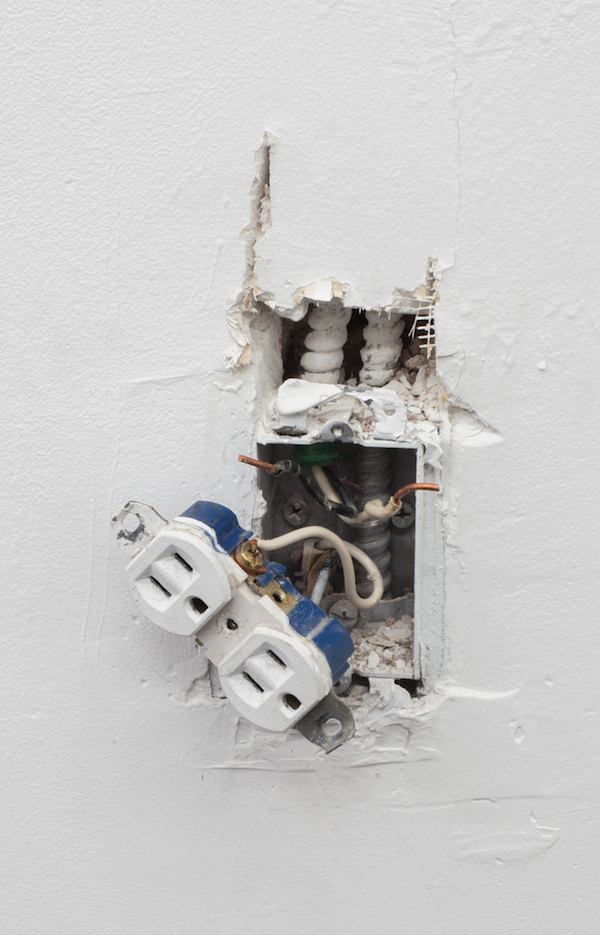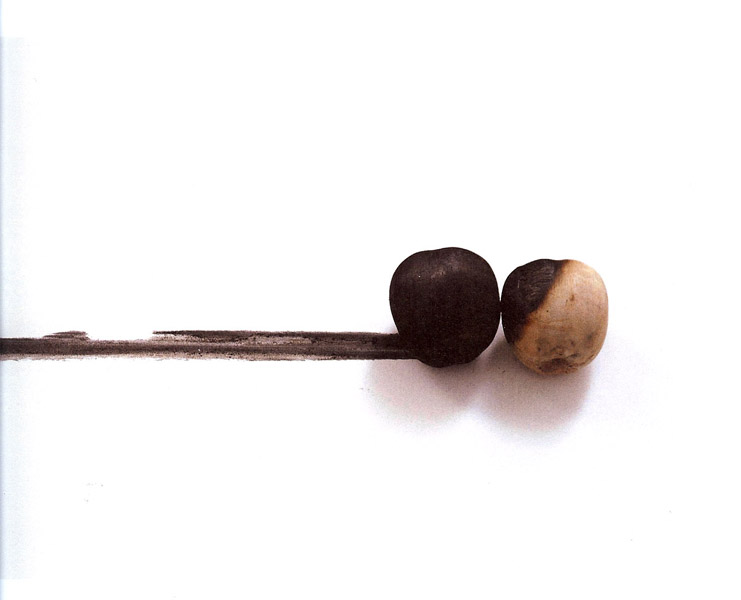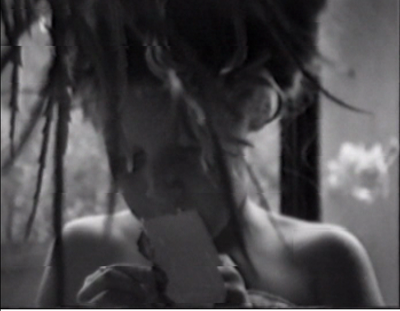
© » KADIST
Miguel Calderon
Tropical Vulture is a cross-generational project which highlights the artistic influences between George Kuchar, a Bay Area legend of independent filmmaking, and Mexican artist Miguel Calderón. Conversations with a Tropical Vulture is an experimental narrative video, co-directed by both artists, and blends Hollywood glamour and drama with an all-too-real life approach, which creates and inspires a counterpoint of unattainable desire against unbearable actuality. The video, shot on location in Acapulco, utilizes a “lo-fi” aesthetic and playful use of non-professional actors.

© » KADIST
Calderón & Piñeros (La Decanatura)
Calderón & Piñeros (La Decanatura) refer to Sólheimasandur as a work that tackles the issue of “the ruin as a tourist destination.” As they say, “at the end, tourists become an essential part of this unusual, beautiful, and—at the same time—banal landscape.” The video features a plane wreck on Sólheimasandur beach in Iceland, where a navy plane belonging to the United States Army crashed in 1973 due to fuel exhaustion. The plane appears as an anthropomorphized figure: lying on the sands of the beach without its wings, it resembles a sculptural torso that has lost all its limbs, with cables coming out of its body appearing as internal organs. These injuries remind the viewer of the danger inherent in these artifacts, and the potential for both heroism and death implicit in flying them to far-away territories.

© » KADIST
Miguel Angel Rojas
Drawing & Print (Drawing & Print)
In his paper-based work, Medellin-New York , Rojas uses coca leaves and dollar bills to spell out the words of the two cities, tied together through the illicit exchange of materials used to make the word, gesturing towards the uncomfortable reality of the drug trafficking trade and the complicity of both America and Colombia within that economic system.

© » KADIST
Calderón & Piñeros (La Decanatura)
In Centro Espacial Satelital de Colombia (Colombian Satellite Space Center) , Calderón & Piñeros (La Decanatura) play tribute to two “stunning” satellite antennas installed in the small municipality of Chocontá where, in 1970, the Space Communications Center of Colombia was inaugurated. That same year, the first antenna, responsible for the transmission (via microwave) of radio and telephone signals was put in place and eleven years later, the second antenna or Ground Station for International Communications would complete the complex known as Space Communications Center. Excursions to visit what became known as the “Satellite City of Colombia” were common for decades.

© » KADIST
Manuel Solano
Since Manuel Solano became blind, they developed a technique that relies on audio descriptions that allow for an assistant to place pins and threads on a grid that guides the artist’s hands through the surface. In Los Abuelos , the artist works with a canvas the size of their body, allowing intense interaction with the wet paint. This kind of tactility creates a complex entanglement of color masses alternating sharp and blurred details, giving the image an erratic and affective atmosphere just as our fond memories often appear to us.

© » KADIST
Cameron Rowland
Rowland’s minimal installations require a focus not on the objects themselves, but on the conditions of their creation, use, and distribution. Who controls the services that contemporary citizens take for granted—like power, water, heat? Who makes these objects that deliver these services?

© » KADIST
Miguel Angel Ríos
Superb production values and special effects that in the hands of Miguel Angel Rios do not get in the way or distracts from the content and deep essay of this work. The shadow of Modernity represented via a clear cube floats over and through a barren landscape in Latin America. Juxtaposing the corrupt politics of the land, with the artist’s struggles and questioning of the effects and burden of influence of Modernity.

© » KADIST
Miguel Angel Ríos
For Piedras Blancas , arguably his most ambitious and visually arresting video to date, Miguel Angel Ríos made 3,000 “piedras” out of a concrete/stone composite. The video is shot in arid, mountainous locations in Mexico (his adopted country) and Argentina (his home country). Over several months, Ríos scouted locations for natural-worn tributaries where he eventually allowed these balls to then thunder down the mountain.

© » KADIST
Michel Auder
The Town consists of footage taken from Auder’s studio of the skyline of New York, tracking planes as they fly across the sky and pass tall buildings. At the time of recording, like all of this films, there was no particular intent. However, in the aftermath of 9/11, this film becomes prescient and ominously prophetic.

© » KADIST
Michel François
Drawing & Print (Drawing & Print)
In Michel François’s work, « it is the real, physical and emotional experience that stimulates creation which is therefore highly charged with a vital force. There lies also the profoundly and clandestine figurative nature of his work » (Guillaume Désanges). Contamination is a constant in Michel François’s work.

© » KADIST
Manuel Correa
Manuel Correa’s short film Didn’t Know I Died is a testimonial portrait of the acclaimed Colombian poet Olga Elena Mattei. Earlier in her life during a simple medical operation, Mattei was declared medically dead. In the film, she recounts her first memory upon waking up, a dream.

© » KADIST
Manuel Correa
Manuel Correa’s documentary Four Hundred Unquiet Graves is a powerful and vulnerable visual essay about the descendants of those who were disappeared during the Spanish Civil War from 1936–1939. The film reveals the spectrum of violence that surrounds the war, namely the impact of thousands of forced disappearances on different generations. Surviving family members are haunted not only by the absence of their grandparents, but also by the overwhelming grief that lives in their parents.

© » KADIST
Michel Auder
Talking Head is a short film in black and white of Auder’s daughter Alexandra, hidden behind a hemp plant, playing with a plastic wrapper and babbling in an imaginative way. The viewer is uncertain whether Alexandra knows she is being filmed but given that Auder was constantly filming she was probably oblivious to it. Her statements make little sense to the outsider : ‘The thing never came back again.

© » KADIST
Manuel Correa
La Forma del Presente (The Shape of Now) by Manuel Correa follows a group of survivors of Colombia’s 50-year long armed conflict facing the impossible task of agreeing on a shared past. After half a century of carnage, Colombia achieved peace. Despite an agreement between the government and the Revolutionary armed forces of Colombia (FARC_EP) being rejected by popular vote, the government chose to implement the agreements regardless, further polarizing the public opinion.

© » KADIST
Miguel and Natalia Fernández de Castro and Mendoza
The Absolute Restoration of All Things is a collaboration by artist Miguel Fernández de Castro and anthropologist Natalia Mendoza. For this project, Fernández de Castro and Mendoza researched the 2014 court case that shut down Penmont Mining’s operations in the middle of the Sonoran desert. The lawsuit was brought to court by the “ejidatarios” (communal land holders) of El Bajío, Sonora, who claimed that their territory was illegally occupied and exploited, causing an irrevocable environmental impact on their land.
Manuel Correa
Manuel Correa’s practice deals with the reconstruction of post-conflict intergenerational memory in contemporary societies...
Michel Auder
Michel Auder was born in 1945 in Soissons, France...
Miguel Angel Rojas
For Colombian artist Miguel Ángel Rojas, issues of economic and social inequality in his native country provide fodder to his artistic practice...
Manuel Solano
Manuel Solano, who is non-binary and prefers plural pronouns, was an emerging 26-year-old artist when they lost their sight to an HIV-related infection in 2013...
Cameron Rowland
Cameron Rowland bases his practice on re-contextualizing everyday objects in ways to highlight the economic and political forces that influence our immediate surroundings, exposing dynamics that are often overlooked, hiding in plain sight...
Miguel Calderon
Miguel Calderón is a Mexican artist and writer...
-
1980-1989
Michel Auder
1981Talking Head is a short film in black and white of Auder’s daughter Alexandra, hidden behind a hemp plant, playing with a plastic wrapper and babbling in an imaginative way...
-
1990-1999
Michel Auder
1999The Town consists of footage taken from Auder’s studio of the skyline of New York, tracking planes as they fly across the sky and pass tall buildings...
-
2000-2009
Michel François
Drawing & Print
2004(Drawing & Print) In Michel François’s work, « it is the real, physical and emotional experience that stimulates creation which is therefore highly charged with a vital force...
Miguel Calderon
2009Tropical Vulture is a cross-generational project which highlights the artistic influences between George Kuchar, a Bay Area legend of independent filmmaking, and Mexican artist Miguel Calderón...
-
2010-2019
Miguel Angel Rojas
Drawing & Print
2011(Drawing & Print) In his paper-based work, Medellin-New York , Rojas uses coca leaves and dollar bills to spell out the words of the two cities, tied together through the illicit exchange of materials used to make the word, gesturing towards the uncomfortable reality of the drug trafficking trade and the complicity of both America and Colombia within that economic system....
Miguel Angel Ríos
2012Superb production values and special effects that in the hands of Miguel Angel Rios do not get in the way or distracts from the content and deep essay of this work...
Cameron Rowland
2014Rowland’s minimal installations require a focus not on the objects themselves, but on the conditions of their creation, use, and distribution...
Miguel Angel Ríos
2014For Piedras Blancas , arguably his most ambitious and visually arresting video to date, Miguel Angel Ríos made 3,000 “piedras” out of a concrete/stone composite...
Calderón & Piñeros (La Decanatura)
2015In Centro Espacial Satelital de Colombia (Colombian Satellite Space Center) , Calderón & Piñeros (La Decanatura) play tribute to two “stunning” satellite antennas installed in the small municipality of Chocontá where, in 1970, the Space Communications Center of Colombia was inaugurated...
Calderón & Piñeros (La Decanatura)
2018Calderón & Piñeros (La Decanatura) refer to Sólheimasandur as a work that tackles the issue of “the ruin as a tourist destination.” As they say, “at the end, tourists become an essential part of this unusual, beautiful, and—at the same time—banal landscape.” The video features a plane wreck on Sólheimasandur beach in Iceland, where a navy plane belonging to the United States Army crashed in 1973 due to fuel exhaustion...
Manuel Correa
2018La Forma del Presente (The Shape of Now) by Manuel Correa follows a group of survivors of Colombia’s 50-year long armed conflict facing the impossible task of agreeing on a shared past...
-
2020-2029
Manuel Solano
2020Since Manuel Solano became blind, they developed a technique that relies on audio descriptions that allow for an assistant to place pins and threads on a grid that guides the artist’s hands through the surface...
Manuel Correa
2020Manuel Correa’s short film Didn’t Know I Died is a testimonial portrait of the acclaimed Colombian poet Olga Elena Mattei...
Manuel Correa
2020Manuel Correa’s documentary Four Hundred Unquiet Graves is a powerful and vulnerable visual essay about the descendants of those who were disappeared during the Spanish Civil War from 1936–1939...
Miguel and Natalia Fernández de Castro and Mendoza
2022The Absolute Restoration of All Things is a collaboration by artist Miguel Fernández de Castro and anthropologist Natalia Mendoza...